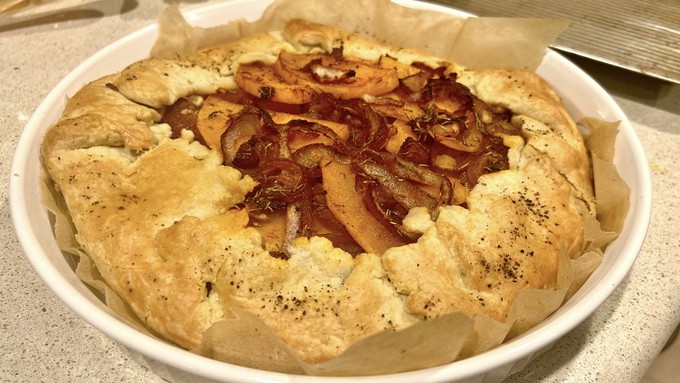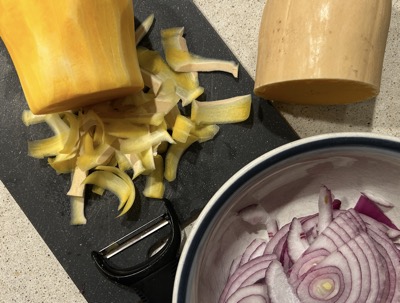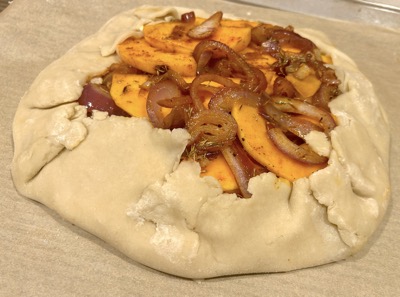
Recipe: Premade crust, herbed soft cheese can speed up the prep work

Piled with butternut squash slices and red onion, this galette can be made easily with some shortcut ingredients. (Galette was baked on a cookie sheet but moved to a tart pan for easy serving.) Kathy Morrison
By this point in November, most folks have their Thanksgiving menu planned, if not in progress. So I'm not going to advise including this recipe in the holiday lineup.
However, if you are headed to a potluck, need a vegetarian dish, or just need a quick meal for a day that's not Thursday, give this butternut squash galette a look. It's a back-pocket recipe that can be speeded up with some shortcut ingredients.
A galette is a rustic pie that can be filled with sweet or savory fillings. Since it's baked on a flat sheet, it's done in much less time than a standard pie or quiche. If you want to make your own crust, this one from Dorie Greenspan is my favorite; reduce the sugar to 1 teaspoon for a savory dough.

But I didn't have the time, and I had a premade Trader Joe's crust in the freezer that I wanted to use up. So that became the base.
The original New York Times recipe I adapted called for fresh goat cheese, mixed with fresh herbs. Again I reached for a premade ingredient: A package of goat cheese with garlic and herbs added. That worked fine, though I'll do something else next time. The goat cheese was a little too piquant for the mellow butternut, and I realized that standard cream cheese augmented with my fresh herbs (not the stuff in tubs) would be a better pairing. Both cheese possibilities are in the recipe below.
My other adjustment was to sweat the red onions before they went into the galette filling. I didn't think they'd get cooked enough if they went into the oven raw. And after tasting the galette, I was glad I did that. Also, yellow or white onions or even shallots would work equally well.
Butternut squash can be peeled with a vegetable peeler, a much safer method than cutting off the skin with a knife. I used about half a standard size squash. Be sure to slice it thin so it will cook to tenderness.
Butternut squash galette with onions and soft cheese
Serves 6 to 8
Ingredients:
One (12-ounce) refrigerated premade pie crust or 9-inch homemade galette crust
1 cup thinly sliced red, white or yellow onion, or shallots
1-1/2 tablespoons olive oil, divided
2 generous cups peeled and thinly sliced butternut squash (1/8-inch slices ideal)
1 teaspoon smoked paprika
4 ounces fresh goat cheese (plain or containing herbs) or good-quality brick cream cheese, softened to room temperature
1 to 2 tablespoons fresh chopped mixed herbs such as chives, thyme leaves, sage, marjoram or winter savory (this is optional if using herbed goat cheese)
Salt and pepper to taste
Half and half or milk, for brushing crust
Olive oil or balsamic vinegar, for drizzling, optional
Instructions:
Preheat the oven to 375 degrees. Line a flat baking sheet with parchment paper and set aside.
In a skillet on medium heat, warm 1 tablespoon olive oil and add the onion slices and a sprinkling of salt. Cook, stirring occasionally, until the onions are translucent but not brown.

Scrape the onions into a large bowl, add the butternut squash slices, the remaining 1/2 tablespoon of oil and the paprika, plus salt and freshly ground pepper to taste. Stir to combine, then set aside while you prepare the galette.
In a small bowl, stir together the softened cheese, the prepared herbs and a sprinkle or two of salt and pepper.
Roll out or unfold the galette crust on a lightly floured surface. It should be about 12 inches across. The crust does not need an even edge; shaggy edges give the galette its visual charm. Move the crust to the prepared baking sheet. (Speed-up tip: If using a premade crust, put it directly onto the parchment-covered sheet and proceed as above.)
Using an offset spatula, spread the herbed cheese in a thin layer over the dough, leaving a 2-inch border of crust uncovered.
Now add the squash and onion mixture, arranging it as evenly as possible over the cheese layer. Fold or pleat the outer edge of the crust over the vegetables, leaving the center uncovered. Moisten the crust's edges lightly with water as needed so the folds will stick together.
Brush the crust with some half and half or milk, and grind black pepper to taste over the crust.
Bake for 35 to 45 minutes until the crust is golden and the squash is tender. (Tent with foil if the crust is browning too fast). Allow the galette to rest for 5 minutes after removing from the oven. Serve warm or room temperature. Drizzle the filling with a bit of olive oil or balsamic vinegar if desired before serving.
Comments
0 comments have been posted.Sacramento Digs Gardening to your inbox.
Food in My Back Yard Series
May 6: Maintain soil moisture with mulch for garden success
April 29: What's (already) wrong with my tomato plants?
April 22: Should you stock up on fertilizer? (Yes!)
April 15: Grow culinary herbs in containers
April 8: When to plant summer vegetables
April 1: Don't be fooled by these garden myths
March 25: Fertilizer tips: How to 'feed' your vegetables for healthy growth
March 18: Time to give vegetable seedlings some more space
March 11: Ways to win the fight against weeds
March 4: Potatoes from the garden
Feb. 25: Plant a fruit tree now -- for later
Feb. 18: How to squeeze more food into less space
Feb. 11: When to plant? Consider staggering your transplants
Feb. 4: Starting in seed starting
Sites We Like
Garden Checklist for week of May 4
Enjoy this spring weather – and get gardening!
* Plant, plant, plant! It’s prime planting season in the Sacramento area. Time to set out those tomato transplants along with peppers and eggplants. Pinch off any flowers on new transplants to make them concentrate on establishing roots instead of setting premature fruit.
* Direct-seed melons, cucumbers, summer squash, corn, radishes, pumpkins and annual herbs such as basil.
* Harvest cabbage, lettuce, peas and green onions.
* In the flower garden, direct-seed sunflowers, cosmos, salvia, zinnias, marigolds, celosia and asters. (You also can transplant seedlings for many of the same flowers.)
* Plant dahlia tubers. Other perennials to set out include verbena, coreopsis, coneflower and astilbe.
* Transplant petunias, marigolds and perennial flowers such as astilbe, columbine, coneflowers, coreopsis, dahlias, rudbeckia and verbena.
* Keep an eye out for slugs, snails, earwigs and aphids that want to dine on tender new growth.
* Feed summer bloomers with a balanced fertilizer.
* For continued bloom, cut off spent flowers on roses as well as other flowering plants.
* Add mulch to the garden to maintain moisture. Mulch also cuts down on weeds. But don’t let it mound around the stems or trunks of trees or shrubs. Leave about a 6-inch to 1-foot circle to avoid crown rot or other problems.